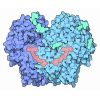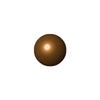+ Open data
Open data
- Basic information
Basic information
| Entry | Database: PDB / ID: 8dsl | ||||||
|---|---|---|---|---|---|---|---|
| Title | Peptidylglycine alpha hydroxylating monooxygenase, Q272E | ||||||
 Components Components | Peptidylglycine alpha-amidating monooxygenase | ||||||
 Keywords Keywords | OXIDOREDUCTASE / copper / peptidylglycine alpha hydroxylating monooxygenase | ||||||
| Function / homology |  Function and homology information Function and homology informationpeptidylglycine monooxygenase / peptidylamidoglycolate lyase / peptide amidation / peptidylglycine monooxygenase activity / peptidylamidoglycolate lyase activity / fatty acid primary amide biosynthetic process / ovulation cycle process / toxin metabolic process / long-chain fatty acid metabolic process / peptide metabolic process ...peptidylglycine monooxygenase / peptidylamidoglycolate lyase / peptide amidation / peptidylglycine monooxygenase activity / peptidylamidoglycolate lyase activity / fatty acid primary amide biosynthetic process / ovulation cycle process / toxin metabolic process / long-chain fatty acid metabolic process / peptide metabolic process / mitotic chromosome condensation / response to pH / L-ascorbic acid binding / limb development / response to zinc ion / response to copper ion / transport vesicle membrane / maternal process involved in female pregnancy / condensed chromosome / lactation / response to glucocorticoid / secretory granule / regulation of actin cytoskeleton organization / trans-Golgi network / response to estradiol / heart development / perikaryon / response to hypoxia / response to xenobiotic stimulus / copper ion binding / neuronal cell body / calcium ion binding / chromatin binding / regulation of transcription by RNA polymerase II / protein kinase binding / chromatin / perinuclear region of cytoplasm / cell surface / extracellular space / extracellular region / zinc ion binding / identical protein binding Similarity search - Function | ||||||
| Biological species |  | ||||||
| Method |  X-RAY DIFFRACTION / X-RAY DIFFRACTION /  SYNCHROTRON / SYNCHROTRON /  MOLECULAR REPLACEMENT / Resolution: 2.05 Å MOLECULAR REPLACEMENT / Resolution: 2.05 Å | ||||||
 Authors Authors | Arias, R.J. / Blackburn, N.J. | ||||||
| Funding support |  United States, 1items United States, 1items
| ||||||
 Citation Citation |  Journal: Protein Sci. / Year: 2023 Journal: Protein Sci. / Year: 2023Title: New structures reveal flexible dynamics between the subdomains of peptidylglycine monooxygenase. Implications for an open to closed mechanism. Authors: Arias, R.J. / Welch, E.F. / Blackburn, N.J. | ||||||
| History |
|
- Structure visualization
Structure visualization
| Structure viewer | Molecule:  Molmil Molmil Jmol/JSmol Jmol/JSmol |
|---|
- Downloads & links
Downloads & links
- Download
Download
| PDBx/mmCIF format |  8dsl.cif.gz 8dsl.cif.gz | 137.8 KB | Display |  PDBx/mmCIF format PDBx/mmCIF format |
|---|---|---|---|---|
| PDB format |  pdb8dsl.ent.gz pdb8dsl.ent.gz | 105.8 KB | Display |  PDB format PDB format |
| PDBx/mmJSON format |  8dsl.json.gz 8dsl.json.gz | Tree view |  PDBx/mmJSON format PDBx/mmJSON format | |
| Others |  Other downloads Other downloads |
-Validation report
| Summary document |  8dsl_validation.pdf.gz 8dsl_validation.pdf.gz | 2.4 MB | Display |  wwPDB validaton report wwPDB validaton report |
|---|---|---|---|---|
| Full document |  8dsl_full_validation.pdf.gz 8dsl_full_validation.pdf.gz | 2.4 MB | Display | |
| Data in XML |  8dsl_validation.xml.gz 8dsl_validation.xml.gz | 29.4 KB | Display | |
| Data in CIF |  8dsl_validation.cif.gz 8dsl_validation.cif.gz | 37.8 KB | Display | |
| Arichive directory |  https://data.pdbj.org/pub/pdb/validation_reports/ds/8dsl https://data.pdbj.org/pub/pdb/validation_reports/ds/8dsl ftp://data.pdbj.org/pub/pdb/validation_reports/ds/8dsl ftp://data.pdbj.org/pub/pdb/validation_reports/ds/8dsl | HTTPS FTP |
-Related structure data
| Related structure data | 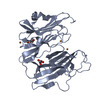 8dsjC 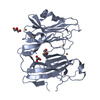 8dsnC 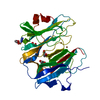 1phmS S: Starting model for refinement C: citing same article ( |
|---|---|
| Similar structure data | Similarity search - Function & homology  F&H Search F&H Search |
- Links
Links
- Assembly
Assembly
| Deposited unit | 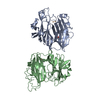
| ||||||||
|---|---|---|---|---|---|---|---|---|---|
| 1 | 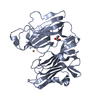
| ||||||||
| 2 | 
| ||||||||
| Unit cell |
|
- Components
Components
| #1: Protein | Mass: 34578.625 Da / Num. of mol.: 2 / Mutation: Q272E Source method: isolated from a genetically manipulated source Source: (gene. exp.)   References: UniProt: P14925, peptidylglycine monooxygenase, peptidylamidoglycolate lyase #2: Chemical | ChemComp-CU / #3: Chemical | #4: Water | ChemComp-HOH / | Has ligand of interest | Y | Has protein modification | Y | |
|---|
-Experimental details
-Experiment
| Experiment | Method:  X-RAY DIFFRACTION / Number of used crystals: 1 X-RAY DIFFRACTION / Number of used crystals: 1 |
|---|
- Sample preparation
Sample preparation
| Crystal | Density Matthews: 2.51 Å3/Da / Density % sol: 51.03 % |
|---|---|
| Crystal grow | Temperature: 298 K / Method: vapor diffusion, sitting drop / pH: 4.5 Details: Hampton Research Cryschem 24-well plates. 1.5 uL of WT PHM protein at 17 mg/mL in 20 mM sodium phosphate, pH 7.5 was added to 1.5 uL of mother liquor solution containing 16-18% PEG 20K, 20- ...Details: Hampton Research Cryschem 24-well plates. 1.5 uL of WT PHM protein at 17 mg/mL in 20 mM sodium phosphate, pH 7.5 was added to 1.5 uL of mother liquor solution containing 16-18% PEG 20K, 20-250 mM sodium citrate, and 2 mM CuSO4. Plates were sealed using transparent tape. Crystals were formed within one week, and these initial crystals were used to seed succeeding trays using the same crystal conditions. Seeding was performed using a Hampton Research seed bead and Hampton Research seeding tool. Initial crystals (5-7 crystals) were vortexed with seed beads for 30 seconds in 30 uL mother liquor, and streaked into a new drop using the seeding tool. PH range: 4-5 |
-Data collection
| Diffraction | Mean temperature: 100 K / Serial crystal experiment: N |
|---|---|
| Diffraction source | Source:  SYNCHROTRON / Site: SYNCHROTRON / Site:  SSRL SSRL  / Beamline: BL12-2 / Wavelength: 0.979 Å / Beamline: BL12-2 / Wavelength: 0.979 Å |
| Detector | Type: DECTRIS PILATUS3 6M / Detector: PIXEL / Date: Jan 16, 2021 |
| Radiation | Monochromator: M / Protocol: SINGLE WAVELENGTH / Monochromatic (M) / Laue (L): M / Scattering type: x-ray |
| Radiation wavelength | Wavelength: 0.979 Å / Relative weight: 1 |
| Reflection | Resolution: 2.05→38.25 Å / Num. obs: 41882 / % possible obs: 98.1 % / Redundancy: 8.9 % / CC1/2: 0.999 / Rmerge(I) obs: 0.071 / Rpim(I) all: 0.025 / Rrim(I) all: 0.076 / Net I/σ(I): 15.9 |
| Reflection shell | Resolution: 2.05→2.11 Å / Redundancy: 8.7 % / Rmerge(I) obs: 0.539 / Mean I/σ(I) obs: 3.5 / Num. unique obs: 3186 / CC1/2: 0.95 / Rpim(I) all: 0.194 / Rrim(I) all: 0.574 / % possible all: 96.8 |
- Processing
Processing
| Software |
| ||||||||||||||||||||||||||||||||||||||||||||||||||||||||||||
|---|---|---|---|---|---|---|---|---|---|---|---|---|---|---|---|---|---|---|---|---|---|---|---|---|---|---|---|---|---|---|---|---|---|---|---|---|---|---|---|---|---|---|---|---|---|---|---|---|---|---|---|---|---|---|---|---|---|---|---|---|---|
| Refinement | Method to determine structure:  MOLECULAR REPLACEMENT MOLECULAR REPLACEMENTStarting model: 1phm Resolution: 2.05→38.25 Å / Cor.coef. Fo:Fc: 0.957 / Cor.coef. Fo:Fc free: 0.937 / SU B: 4.903 / SU ML: 0.131 / Cross valid method: THROUGHOUT / σ(F): 0 / ESU R: 0.206 / ESU R Free: 0.178 / Stereochemistry target values: MAXIMUM LIKELIHOOD Details: HYDROGENS HAVE BEEN ADDED IN THE RIDING POSITIONS U VALUES : REFINED INDIVIDUALLY
| ||||||||||||||||||||||||||||||||||||||||||||||||||||||||||||
| Solvent computation | Ion probe radii: 0.8 Å / Shrinkage radii: 0.8 Å / VDW probe radii: 1.2 Å / Solvent model: MASK | ||||||||||||||||||||||||||||||||||||||||||||||||||||||||||||
| Displacement parameters | Biso max: 133.59 Å2 / Biso mean: 43.646 Å2 / Biso min: 18.43 Å2
| ||||||||||||||||||||||||||||||||||||||||||||||||||||||||||||
| Refinement step | Cycle: final / Resolution: 2.05→38.25 Å
| ||||||||||||||||||||||||||||||||||||||||||||||||||||||||||||
| Refine LS restraints |
| ||||||||||||||||||||||||||||||||||||||||||||||||||||||||||||
| LS refinement shell | Resolution: 2.05→2.103 Å / Rfactor Rfree error: 0 / Total num. of bins used: 20
|
 Movie
Movie Controller
Controller



 PDBj
PDBj


